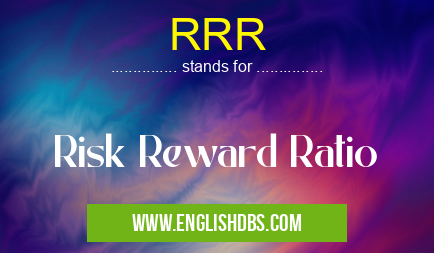What does RRR mean in UNCLASSIFIED
RRR stands for Risk Reward Ratio, which is a metric used in finance to assess the potential return of an investment relative to the risk involved. It is calculated by dividing the potential profit by the potential loss. A higher RRR indicates a more favorable investment opportunity, as it suggests a greater potential return for a given level of risk.

RRR meaning in Unclassified in Miscellaneous
RRR mostly used in an acronym Unclassified in Category Miscellaneous that means Risk Reward Ratio
Shorthand: RRR,
Full Form: Risk Reward Ratio
For more information of "Risk Reward Ratio", see the section below.
Importance of RRR
RRR is a crucial tool for investors as it helps them make informed decisions by evaluating the trade-off between potential reward and risk. It allows investors to:
- Quantify Investment Risk: RRR provides a numerical measure of the potential loss associated with an investment, helping investors assess the downside risk.
- Compare Investment Opportunities: By comparing the RRR of different investments, investors can identify those that offer the best balance of return and risk.
- Manage Risk Tolerance: RRR helps investors determine whether an investment aligns with their risk tolerance, ensuring they invest within their comfort level.
How to Calculate RRR
The formula for calculating RRR is:
RRR = (Potential Profit) / (Potential Loss)Potential Profit: This is the difference between the expected sale price and the purchase price of the investment.
Potential Loss: This is the difference between the purchase price and the expected worst-case scenario sale price of the investment.
Interpretation of RRR
- RRR > 1: Indicates a potentially profitable investment with a positive expected return.
- RRR = 1: Indicates a break-even investment where the potential profit is equal to the potential loss.
- RRR < 1: Indicates a potentially unprofitable investment with a negative expected return.
Essential Questions and Answers on Risk Reward Ratio in "MISCELLANEOUS»UNFILED"
What is Risk Reward Ratio (RRR)?
RRR is a financial metric that compares the potential return of an investment to the potential loss. It is expressed as a ratio, where the numerator represents the potential profit and the denominator represents the potential loss. The higher the RRR, the more favorable the investment.
How is RRR calculated?
RRR is calculated by dividing the potential profit by the potential loss. The potential profit is the difference between the entry price and the target price, while the potential loss is the difference between the entry price and the stop-loss price.
What is a good RRR?
There is no definitive answer to this question, as it depends on the individual trader's risk tolerance and investment goals. However, a RRR of 1:2 or higher is generally considered to be a good ratio.
How can I use RRR to make better investment decisions?
RRR can be used to assess the potential risk and reward of an investment. By comparing the potential profit to the potential loss, investors can make more informed decisions about which investments to make.
What are the limitations of RRR?
RRR is a useful metric, but it has some limitations. It does not take into account the time period of the investment, and it does not consider the volatility of the asset.
Final Words: RRR is a powerful tool that enables investors to make informed decisions by assessing the potential return and risk associated with an investment. By understanding and interpreting RRR, investors can optimize their portfolios and increase their chances of achieving their financial goals.
